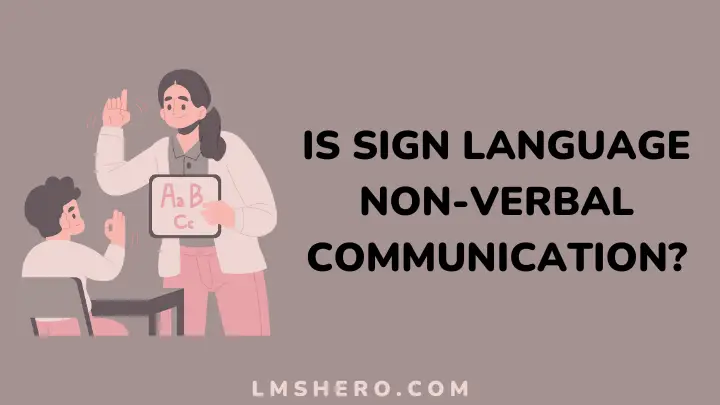Non-verbal communication is an essential component of human interaction. We often think of it as body language or facial expressions, but did you know that communication goes beyond these gestures? Sign language is a unique and complex form of non-verbal communication that uses hand movements, facial expressions, and body postures to convey thoughts, emotions, and ideas.
This article will explore the fascinating world of sign language, its history and evolution, its impacts on society, and other examples of non-verbal communication. I will delve into the grammar and syntax of sign language, the origins of this rich language, and how it has impacted society.
So, come on this journey with me to learn about the beautiful world of sign language and how it has become an integral part of non-verbal communication.
Understanding sign language: more than just hand gestures
Sign language is a fascinating and complex system of communication that goes beyond hand gestures.
It involves a combination of hand movements, facial expressions, and body postures to express thoughts, emotions, and ideas.
It’s a distinct language with its grammar and syntax, and it has a deep-rooted history, evolving within deaf communities globally.
The origins of sign language
Historically, sign language has been used as a method of communication since the early 17th century. Yet, hand gestures have been used as a form of communication as far back as the 5th century BC in Greece.
Over the centuries, it has thrived and become an integral part of deaf culture. Today, sign languages are used by millions of people around the world, and each country has its own unique sign language.
For example, American Sign Language (ASL), British Sign Language (BSL), and Auslan (Australian Sign Language) are just a few examples, each with its own set of gestures and syntax.
The origins and evolution of sign language have been deeply intertwined with the history and experiences of deaf communities globally.
Despite facing discrimination and marginalization, deaf individuals have persevered and developed a rich, complex language worthy of admiration.
Sign language vs. spoken language: bridging the gap
Sign language is not a mere translation of spoken language; it’s a unique language with its grammar and syntax. Understanding this fundamental difference is essential for appreciating its unique qualities and significance.
With its ability to convey emotions and nuances, sign language is vital in bridging communication gaps and enabling effective communication between people. It’s a beautiful non-verbal form of communication that is worthy of admiration.
Is sign language non-verbal communication?

Yes. Sign language is a fascinating and effective form of non-verbal communication used by people for centuries. This visual language uses a combination of hand movements, facial expressions, and body postures to convey thoughts, feelings, and ideas.
Sign language is not only limited to those who are deaf or hard of hearing but is also utilized by people who cannot speak for various reasons. It is a complex, rich language with grammar, syntax, and vocabulary.
With its ability to convey emotions and nuances, sign language is vital in bridging communication gaps and enabling effective communication between people. Sign language is a unique and beautiful non-verbal communication worthy of admiration.
Sign language and its impact on society
As a form of communication, sign language is not limited to personal or non-verbal communication but profoundly impacts society. It promotes inclusivity by breaking down communication barriers and fostering understanding among people from diverse backgrounds.
Communicating through sign language enables individuals with hearing impairments to connect with the world around them and participate fully in society. It also helps to bridge the gap between people with different languages and cultures, promoting mutual respect and understanding.
It is vital to create an inclusive and accessible society where everyone can communicate and express themselves freely.
Sign language interpreters: bridging communities
Sign language interpreters facilitate non-verbal communication between deaf individuals and the hearing world. They act as bridges, translating spoken language into sign language and vice versa, enabling effective communication in various settings.
These settings may include conferences, legal proceedings, healthcare environments, and everyday interactions. Deaf individuals would face significant challenges in accessing information and communicating with others without interpreters.
This highlights the indispensable role of interpreters in fostering inclusivity and promoting equal access to communication for all.
Sign language in media and arts
The influence of sign language in the realm of media and arts cannot be overstated. Deaf actors, directors, and writers have significantly contributed to the entertainment industry, creating powerful narratives that resonate with audiences worldwide.
Sign language allows These individuals to tell unique, authentic, and deeply personal stories. Consequently, they have given a voice to deaf experiences and perspectives often overlooked or misrepresented in mainstream media.
Their work has brought much-needed diversity to the entertainment industry and helped raise awareness about deaf culture and the importance of inclusivity.
From award-winning films like “The Silent Child” to groundbreaking TV shows like “Switched at Birth,” sign language has been used to tell powerful stories that have touched the hearts of millions.
This proves that sign language is a form of communication that transcends barriers and connects people profoundly.
Sign language in education
In educational settings, sign language is indispensable in facilitating communication and promoting inclusivity for individuals with hearing impairments. To ensure that all students have equal access to education regardless of their hearing abilities, some people advocate teaching sign language in schools and institutions.
Sign language can be integrated into various educational settings, including early childhood, primary, secondary, and tertiary education. Instructors, teachers, and educators undergo training to teach and communicate effectively with sign language users.
Sign language promotes a positive learning experience for students with hearing impairments and creates a more inclusive learning environment. It enables students to participate in class discussions, ask questions, and interact with their peers and instructors, fostering a sense of belonging and community.
Moreover, sign language promotes bilingualism and multilingualism, allowing students to learn a second language and broaden their horizons. This integration of sign language into education is a crucial step towards creating a more accessible and inclusive society.
What are other examples of non-verbal communication?
Non-verbal communication is a fundamental aspect of our daily lives, and it can take many forms. Aside from sign language, facial expressions, gestures, posture, and eye contact are some examples of non-verbal communication.
A simple smile or nod can convey a range of emotions, from happiness to agreement. Similarly, crossed arms or a furrowed brow can indicate discomfort or disagreement. In social situations, non-verbal communication is essential in establishing connections and building relationships.
It can also be used for persuasion, negotiation, and conflict resolution. Therefore, being aware of non-verbal cues can help us communicate more effectively and build stronger relationships.
FAQs
How many variations of sign language exist globally?
About 300 different sign languages are used worldwide, each with its unique vocabulary and grammar.
Is sign language universal?
While there isn’t a single universal sign language, many countries have their own indigenous sign languages. However, there are also international sign languages used in global contexts.
Can anyone learn sign language?
Yes. Sign language is open for everyone to learn. Many communities offer classes and resources to help individuals become proficient in sign language.
Are there different dialects in sign language, similar to spoken languages?
Yes. Sign languages have regional variations and dialects, just like spoken languages. These differences often reflect the cultural diversity within deaf communities.
How does sign language impact cognitive development in children?
Research suggests that learning sign language early can enhance cognitive abilities, improve communication skills, and boost overall brain development in children.
Final Thoughts
In conclusion, sign language is a beautiful and complex non-verbal communication beyond mere hand gestures. It has a deep-rooted history and has evolved within deaf communities globally, making it an integral part of deaf culture.
Sign language is not limited to personal communication but profoundly impacts society, promoting inclusivity and breaking communication barriers. Understanding the intricacies of sign language can help create a world where communication knows no boundaries, and everyone can express themselves freely.
Let’s embrace diversity and foster inclusivity by recognizing the importance of sign language and its unique qualities. Do you wish to learn sign language at your convenience? Here’s how to learn sign language online.
Thanks for reading.







